REGAL PHNOM PENH
Cambodia's Royal Capital
By Rick Millikan
(For Travel Writers' Tales)
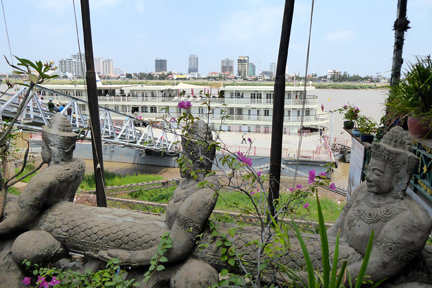
Phnom Penh Moorage
After cruising for six intriguing days through Vietnam, our riverboat arrives in Phnom Penh, Cambodia's capital. Moored along the Mekong, we climb a long stairway to waiting tuk tuks. These motorbike-rickshaws carry us along boulevard parkways dotted with statues of Asian luminaries and jungle wildlife. Zipping between bustling shops, glass high-rises and sprawling temples, we arrive at the King's palace compound.
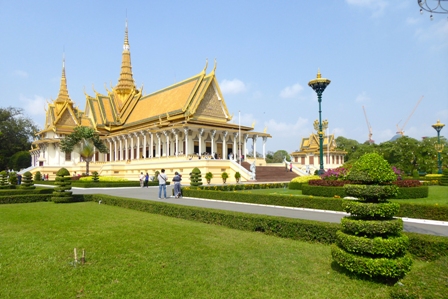
Phnom Penh King's Palace
Near the entrance, a gnarly tree dangles saucer-sized red and yellow flowers and big brown spheres from thick branches. “That's a cannonball tree,” grins local guide Tri. “Lord Buddha was born under such a tree. As 97% of us are Buddhists, it's highly sacred.”
Verdant lawns surround four lemon-yellow palaces. Emerald green tiles form cobras outlining their steep, red-tiled roofs. Twin cobras serve as balustrades for the stairway to the larger palace's terrace. “These snakes represent semi-divine guardians,” Tri explains.
Silver Pagoda's adjacent courtyard encloses wall frescos portraying the Ramayana. “This 642-meter mural replicates Angkor Wat 's bas-reliefs. Scenes of lush countryside, palace life and battles show Prince Rama's quest to free beloved wife Sita from Ravana,” smiles Tri. “See that monkey army? They helped him with this rescue!”
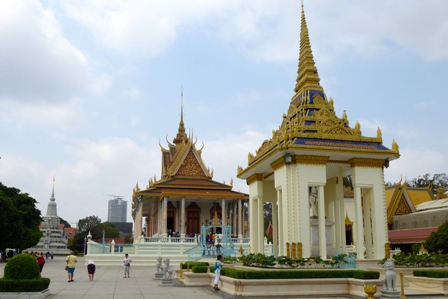
Phnom Penh Silver Temple
Entering the Silver Pagoda, we see only one patch of its silver-tiled floor remains exposed. Carved from Baccarat crystal , the Emerald Buddha sits on a gilded dais. Another stands beside him, cast in gold and studded with diamonds. Sculpted backgrounds of statuettes highlight important episodes during this Indian lord's spiritual journey.
Tall silver-grey stupas encircle the Silver Pagoda, each ornately carved structure holding ashes of the royal family. Near the exit, an elderly duo plays exotic, sweet-sounding xylophones. Back in our tuk-tuk, our driver whisks us off to Cambodia's National Museum, where Monks in saffron robes sit on benches adjacent a large statue of the Elephant God, Ganesh.
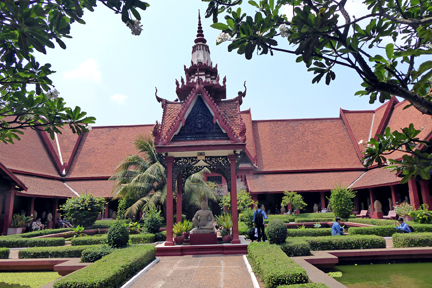
Phnom Penh Museum Courtyard
Entering the red pagoda-styled museum, artifacts trace Southeast Asian development from prehistoric times to the Bronze Age of Angor Wat. Stone statues of Vishnu, Shiva, demi-god monkeys, celestial female spirits and Buddha reflect Cambodia's historic religions. One gallery displays lingam, phallic shaped rocks symbolizing the god Shiva. Lingam rest upon bowls representing, yoni, the goddess Shakti. Together they embody the principle of male and female union and totality of existence.
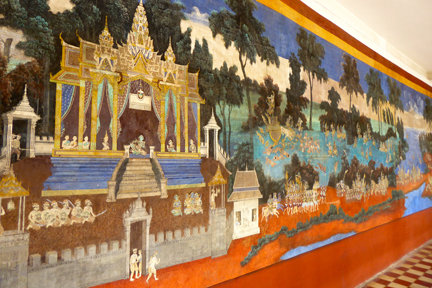
Phnom Penh Silver Temple Mural
In another gallery, a majestic mahogany riverboat is decorated with carved lotus blossoms. This royal barge evokes the leizurely lifestyles of early Khmer kings and queens. Opening onto a floral courtyard, a stone statue of Yama, Hindu god of death stands in the center. Known too as the Leper King, the statue was found discolored, covered in moss reminiscent of someone suffering leprosy.
Next day, traveling through lush countryside, Tri helps us understand today's two sobering destinations. “…Already objecting to Prince Sihanouk becoming Prime Minister, i n 1970 large protests regarding his communist oriented, one-party rule turned violent. The national assembly's anti-communist majority deposed Sihanouk. Exiled in China, he endorsed the communist Khmer Rouge. Enlisting Sihanouk and his multitude of followers, their leader Pol Pot seized government in 1975 and began the imprisonment and slaughter of millions of Cambodians. Four years later, Vietnamese troops seized Phnom Penh, toppling Pol Pot's brutal regime and the Khmer Rouge.”
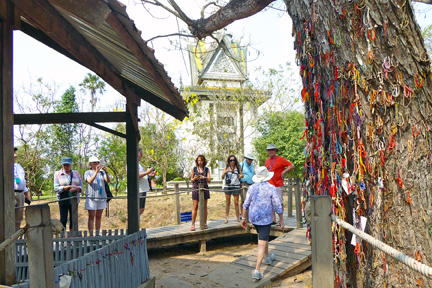
Phnom Penh Killing Fields
Arriving at Killing Fields Memorial Park, a large placard illustrates the weekly truck deliveries of families for execution or transfer to area prisons. Boardwalks loop around mass graves to another sign identifying a fenced gravesite that contained over 450 female bodies. Colorful, blessed string bracelets festoon a tree where guards beat children. A modern white stupa towers in its center paying homage to the victims. This structure encloses over 5,000 skulls. The bleached skulls are encased in glass columns, arranged according to age. This horrific collection reminds us further of this mindless atrocity,
Our last stop is a large city school Pol Pot converted into a prison. Wrapping it in barbed wire, the Khmer Rouge used classrooms to incarcerate, interrogate and torture prisoners. Two rooms exhibit graphic photos of these Cambodians. Metal gallows conjure former hangings. In a sheltered portion of the prison yard, one of seven survivors sells memoirs recounting beatings and general atrocities. He explains how he became the prison repairman, which saved his life.
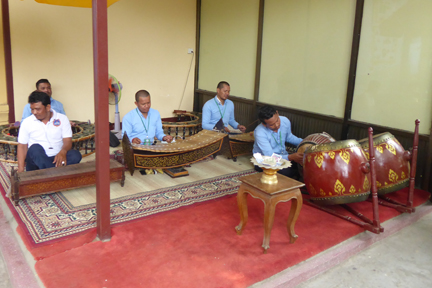
Phnom Penh Combo
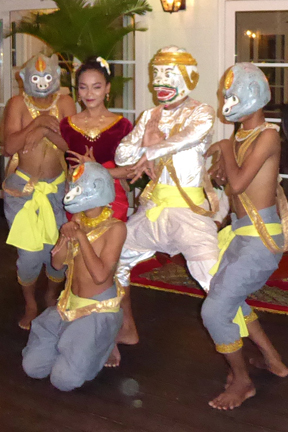
Phnom Penh Shipboard Dancers
Re-boarding Mekong Navigator , we watch upper deck entertainment. Silk-gowned ladies move gracefully to exotic xylophone rhythms. Their royal dances convey mythic tales through classic body gestures. Monkey costumed lads amuse us with stylish antics. Then in trendy suits, these fellows break dance with showy footwork, crab walks, handstands and head spins! This delightful performance ends two insightful, delightful days in Phnom Penh.
IF YOU GO
www.uniworld.com The Wonders of Vietnam, Cambodia and the Mekong and other itineraries.
PHOTOS by Rick and Chris Millikan